Small Problem
I am able to achieve subfolders by following the top answer to this question.
However, as the project grows bigger, you will have many sub-folders:
sourceSets {
main {
res.srcDirs = [
'src/main/res/layouts/somethingA',
'src/main/res/layouts/somethingB',
'src/main/res/layouts/somethingC',
'src/main/res/layouts/somethingD',
'src/main/res/layouts/somethingE',
'src/main/res/layouts/somethingF',
'src/main/res/layouts/somethingG',
'src/main/res/layouts/somethingH',
'src/main/res/layouts/...many more',
'src/main/res'
]
}
}
Not a big problem, but:
- It's not pretty as the list become very long.
- You have to change your
app/build.gradle everytime you add a new folder.
Improvement
So I wrote a simple Groovy method to grab all nested folders:
def getLayoutList(path) {
File file = new File(path)
def throwAway = file.path.split("/")[0]
def newPath = file.path.substring(throwAway.length() + 1)
def array = file.list().collect {
"${newPath}/${it}"
}
array.push("src/main/res");
return array
}
Paste this method outside of the android {...} block in your app/build.gradle.
How to use
For a structure like this:
<project root>
├── app <---------- TAKE NOTE
├── build
├── build.gradle
├── gradle
├── gradle.properties
├── gradlew
├── gradlew.bat
├── local.properties
└── settings.gradle
Use it like this:
android {
sourceSets {
main {
res.srcDirs = getLayoutList("app/src/main/res/layouts/")
}
}
}
If you have a structure like this:
<project root>
├── my_special_app_name <---------- TAKE NOTE
├── build
├── build.gradle
├── gradle
├── gradle.properties
├── gradlew
├── gradlew.bat
├── local.properties
└── settings.gradle
You will use it like this:
android {
sourceSets {
main {
res.srcDirs = getLayoutList("my_special_app_name/src/main/res/layouts/")
}
}
}
Explanation
getLayoutList() takes a relative path as an argument. The relative path is relative to the root of the project. So when we input "app/src/main/res/layouts/", it will return all the subfolders' name as an array, which will be exactly the same as:
[
'src/main/res/layouts/somethingA',
'src/main/res/layouts/somethingB',
'src/main/res/layouts/somethingC',
'src/main/res/layouts/somethingD',
'src/main/res/layouts/somethingE',
'src/main/res/layouts/somethingF',
'src/main/res/layouts/somethingG',
'src/main/res/layouts/somethingH',
'src/main/res/layouts/...many more',
'src/main/res'
]
Here's the script with comments for understanding:
def getLayoutList(path) {
// let's say path = "app/src/main/res/layouts/
File file = new File(path)
def throwAway = file.path.split("/")[0]
// throwAway = 'app'
def newPath = file.path.substring(throwAway.length() + 1) // +1 is for '/'
// newPath = src/main/res/layouts/
def array = file.list().collect {
// println "filename: ${it}" // uncomment for debugging
"${newPath}/${it}"
}
array.push("src/main/res");
// println "result: ${array}" // uncomment for debugging
return array
}
Hope it helps!



